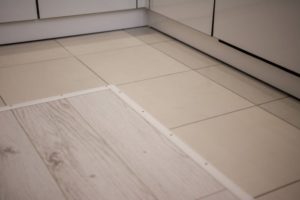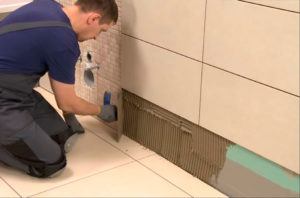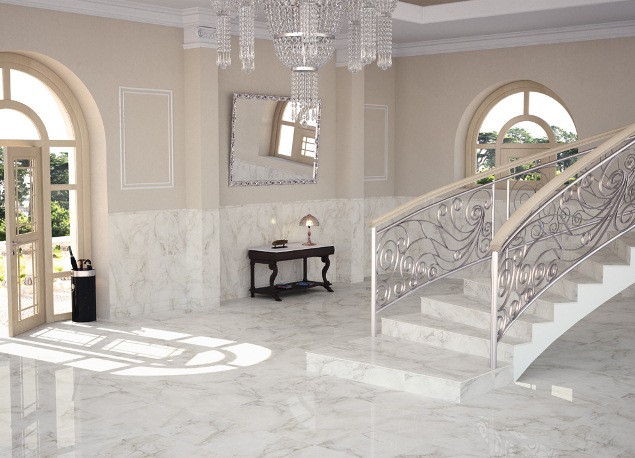Tiles first on the floor or on the walls
 Tile is the best solution for cladding walls and floors in the bathroom, toilet, kitchen and other rooms where a waterproof and durable surface is needed. The process of laying tiles is complicated, but, nevertheless, it can be done independently.
Tile is the best solution for cladding walls and floors in the bathroom, toilet, kitchen and other rooms where a waterproof and durable surface is needed. The process of laying tiles is complicated, but, nevertheless, it can be done independently.
The content of the article
What is the best thing to tile first?
And professionals with many years of experience argue about what to tile first: the floor or the walls? Opinions are contradictory, but both options have their loyal supporters.
Many people prefer to lay the floor first, explaining their choice with several main advantages:
- in this case, the joint between the wall and the floor is easier to control, which means it is possible to make it as inconspicuous as possible;
- Laying walls is much easier from below.
However, the last advantage is lost if, for example, when starting work from the walls, you lay the tiles from a pre-measured gap (to simplify the actions, you can use an ordinary block). In this case, you will not be limited where to start laying tiles: from the ceiling, from below, or, as some advise, from the middle. You can install the baseboard in advance, if, of course, it is included in your renovation plans.
Important: The main rule is to adhere to a single direction of cladding, and not to lay the tiles in a loose order.
There are also conflicting opinions about the advantage, based on the fact that the joint between the walls and the floor is convenient to control only if you start work from below.Many believe that if the master has good skills in this matter, then it will not be difficult for him to make a neat joint even when starting work from the walls, and if his hands are crooked, laying tiles starting from the floors will not save him from a disastrous result.
Why can't it be the other way around?
 Starting work with tiling the walls has more compelling arguments. Everyone can come up with new ones, but, in general, the following statements are the most popular:
Starting work with tiling the walls has more compelling arguments. Everyone can come up with new ones, but, in general, the following statements are the most popular:
- Washing off the glue. In the process of laying tiles on the walls, even the most careful craftsman drips glue, so experienced people strongly advise laying the tiles on the floor at the very end.
Reference: Of course, you can cover the floor with newspapers or film, but they can move during work and simply get in the way. In the case of film, the process becomes completely less safe, since it is easy to slip on it.
- Tools falling. During the installation process, there are often cases when a working tool unexpectedly slips out of your hands. If the floor is already laid, then dropping a heavy object on it can damage the tiles.
- Time for downtime. After laying the tiles, you need to give it time to “rest”, avoiding any impact on it as much as possible. If you start tiling from the walls, then you will not have to interrupt your work, but can immediately start on the floor. Otherwise, you will need to leave the floor for several days, and only then continue laying tiles on the walls.
Recommendations
 When starting to lay tiles, it doesn’t matter which surface you need to level it first. Tile laid on an uneven surface will look untidy and will also be more susceptible to destruction.
When starting to lay tiles, it doesn’t matter which surface you need to level it first. Tile laid on an uneven surface will look untidy and will also be more susceptible to destruction.
It is worth buying tiles with a reserve, since at any moment several units can be accidentally damaged, and tiles from different batches may differ slightly in shade, which will be very noticeable in the general appearance of the room.
And if you decide to start laying tiles from the floor, and then some glue drips in the process, then you need to wipe it off immediately: the sooner, the less effort it will take.
You can write a book here! It doesn't matter to me where to start. But I still lay the tiles from the beginning on the wall from the second row, reducing the dimensions in advance to the floor tiles and glue. This is an average of 1.5 cm. It often happens that floor tiles are difficult to cut even with an electric machine with water. Then I lay all the tiles on the wall, leaving the last row, and then I do the floor and then finish the wall with the last row. Wall material is easier to cut. From the floor, I personally think it’s a little more difficult. And the walls are generally a simpleton! The rules went round and round and bahay. (I have about two dozen of all sizes. I use them to plaster and fill them, and I also screw them to the walls.
Before laying tiles on the walls, I measure the entire floor with a level. And I begin to lay tiles tiles on the walls, taking into account the lowest mark on the floor. This is a guarantee that the baseboard will cover everything and there will be no jambs. Walls first, ceiling, floor last. There was a case where the customer insisted that the floor be done first. I did it.finishing the tiles on the wall (last row), the tile slipped out of my hands, fell, and broke the tiles on the floor. It's difficult to pick it out without damaging the others. How I cursed at the customer. It is something. Oaks, they don’t understand our professionalism. He doesn’t give a damn, but I’m wasting time on this broken tile. And we need to make sure that it doesn’t sink or stick out among the other tiles.
there is only a gap in the floor, and the floor tiles
I allow in exceptional cases gender in the first place. But it’s up to me to decide, not the customer. They did this more than once. But then they covered it with materials and plywood. Invoice to the customer. One day they categorically refused the object. 80 m/2 of glossy porcelain tiles had to be laid. 17th floor, frame house. The customer insisted on installation without seams. There are arguments that there is thermal expansion and, in addition, there is an amplitude of swing of the high-rise candle. Recommendations are in the booklet for the tile itself. She wasn't convinced. Made by other people. A year later he came. The entire floor burst diagonally!
Come on)… it’s much easier to start from the floor, I lasered out the tiles on the floor and then cut the walls without any trimming with the whole tile, that’s half a day, then you have to kill for trimming if you start from the walls without the first row. all the listed disadvantages of starting installation from the floor are insignificant, does the glue fall on the floor? Yes, you can remove it with a spatula in five minutes, even if it’s dried out afterwards; in extreme cases, you can cover the floor with film. And in five years of work I have never (ugh/ugh/ugh) dropped anything on the floor or broken/damaged the tiles on the floor.
Before I start marking the second row, I calculate the tiles so that the last row goes to the ceiling without trimming, or as little trimming as possible (it all depends on how you close the gaps). And the first row will be there as soon as it comes out.
But I'm not afraid of work. But I have seen tears shed by customers and performers, not even a dozen times. Since 1990. Then all the materials and finishing were imported. And not only did they see it, but they laid the tiles. That not only the glue but also fingerprints are difficult or impossible to remove. And you apparently haven’t heard about hydroscopicity classes at all. Even low-quality porcelain tiles absorb. Appearance defective. Just shift it. There are combined ones, even glossy ones. A drop of putty or glue gets on the drawing and that’s it. To be thrown away. Apparently I didn’t come across a parallelogram either. You won’t see it right away, and you won’t be able to identify it from a corner. And already on the 3rd row the seams go away a lot. You need to put it in a special way. algorithm.






First the walls starting from the bottom from the 2nd row. Then the floor. And completes the first row on the walls. This is one of the options.